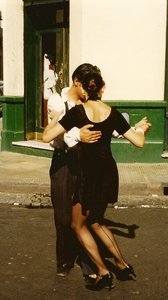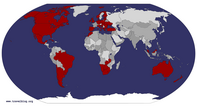Advertisement
Published: December 18th 2008

 San Telmo
San Telmo
Street tango - Vincent & Flavia eat your heart out!Don’t cry for me Argentina! In the good times before economic meltdown and the devaluation of the peso, nobody did. The Argentine currency had parity with the US dollar and the residents of the Paris of South America strolled down their boulevards with confidence. A few eyebrows were raised at the prospect of going to Buenos Aires - it was after all not that far back since a small matter of a rather disputed game of football and a more major fall out. The reality was a very pleasant surprise and the locals turned out by and large to more English in the approach to the world than the English. Where else does society stop for afternoon tea, when the afternoon tea is loose leaf with strainer and not a tea bag. It has been said that an Argentine is “an Italian, who speaks Spanish, who admires French chic and secretly aspires to English”.
The English aspirations can be seen at the many cafes around the city, the most famous of which and worth a visit to is the Café Tortoni. The oldest cafe in the city (founded in 1858) has attracted the distinguished Porteno for many a year and

 103rd Campeonato Argentino Abierto de Polo 1996
103rd Campeonato Argentino Abierto de Polo 1996
Campo Argentino de Polo en Palermo - Alejandro Agte of Martina Mastercard Teamlocals brush shoulders with the tourists in the Av de Mayo premises just along from the Casada Rosada. The back and upstairs rooms have tango shows designed to relieve you of your peso, but we found plenty of free tango on the streets of San Telmo so our advice would be to save your cash. Whilst the Tortoni is an indoor institution that has attracted the great and the good of Argentine society over the years (as well as King Juan Carlos of Spain and Hilary Clinton), our favourite outdoor venue was the Cafe La Biela in the Recoletta area. Cafe La Biela is very much a people watching place - the beautiful people watch other beautiful people just across from the Recoletta Cemetery where Eva Peron is buried.
Whilst the café society of the Buenos Aires gives off a feeling of Edwardian Britain trapped in a time warp, one of the Argentine’s other main passions of football is anything but. Whilst I am sure that the residents of Rosario or La Plata would disagree, the focus of the Argentine pyramid is based firmly on the Capital Federal. The international focus is primarily on River Plate and Boca Juniors,
but there are roughly another 30-40 clubs playing at all levels scattered around the metropolitan area. Simon Inglis described it as the “City of Stadiums” and set about the onerous task of visiting as many as possible in 6 days. It’s a shame I didn’t have the publishing contract to tackle the book first.
This blog is a combination of two trips and first time around, we fell into the trap of hunting out the big two. Alas, River’s home game was postponed due to their involvement the following week in the World Club Championship in Tokyo and Boca Juniors were away from the Bombonera at Banfield in the distant southern suburbs. However, as Boca were closing in on the Clausura Championship and Diego “the hand of God” was back playing out his final days in the team, it seemed the logical choice. Whilst the River postponement was a setback, a stroke of luck came about with the switch of the fixture to the home of Independiente in Avellaneda. Diego did indeed make a token overweight appearance, casually strolling around in the centre circle to rapturous applause, before being substituted. The game also featured a substitute scoring appearance by

 Racing Club De Avellaneda
Racing Club De Avellaneda
Racing Club 4 Boca Juniors 2Claudio Caniggia, fresh from the alleged problems with unknown substances that curtailed his European career. The Boca fans came mob handed to the tune of about 35,000, totally overwhelming the 5,000 or so from the “home” club who were scattered in some half-hearted attempt by 100 or so Boca to “take” their end in a re-run of a 1982 UK terrace. The major pre-occupation in the main Boca terrace was with the respective barras bravas group ensuring a prominent display of their respective banners. The football on offer in the 2-0 Boca win was workmanlike.
We set about exploring the Paris of South America, mainly on foot, on the subway and occasionally by one of the black and yellow taxis. The on foot section was spent strolling the grand boulevards with their copious splashes of colour in the form of many jacaranda trees. The most dramatic avenue in the city itself is the Av 9 de Julio, allegedly the widest avenue in the world. How wide, I can’t remember - but it’s wide! It splits the central area in two with all points drawing your eyes to the Obelisk. The city splits into many barrios or districts, north towards

 Club Athletico River Plate
Club Athletico River Plate
River Plate 4 San Lorenzo 0Recoletta and Palermo and south towards the poor areas by the port of San Telmo and La Boca. San Telmo comes alive especially on a Sunday with street markets and tango, where you can see anything as good as that seen in the $40 shows. The barrio of the port, La Boca, is the home of El Caminito, the brightly coloured street where the buildings appear constructed out of sheet metal and are painted in whatever brightly coloured paint was to hand. In the old days this was probably out of necessity, but maybe that has been superseded by the objective of creating a good photo op for the buses of US tourists. It’s strange mix of a poor neighbourhood, where visitors wander oblivious to the potential dangers around the next corner as they do in the French Quarter in New Orleans and the Bo-kaap in Cape Town. The strange looking bridge over the Riachuelo bears a resemblance to the Transporter. The other major draw in La Boca is La Bombonera, the “Chocolate Box” and home of Club Atletico Boca Juniors. The ground is tightly packed in dense streets, but looks nothing like a chocolate box of course. The colours
of blue and yellow were copied from the next cargo ship to arrive at the time of the formation - it turned out be from Sweden. The ground itself at the time was open door - just wander in through the museum and pay homage to the turf.
In the early days Boca and River were neighbours as well as rivals, before the latter took the opportunity to move to the prosperous north and eventually build El Monumental. The contrast between the two areas is as it is between the two clubs - no open door friendliness at River, just locked gates and surly security guards. The stadium is in line with it’s name enormous compared to Boca. It’s a venue that any schoolboy who watched the 1978 World Cup will feel familiar, except that at a River game the streams of paper descending from the stands are red and white as opposed to the pale blue and white at an international game. It was almost full to it's 70 odd thousand capacity for our visit versus San Lorenzo, who capitulated 4-0 to a River team containing Julio Cruz (who’d arrived from Banfield after the previous year), Marcelo Salas

 La Boca
La Boca
El Caminitoand Jan Pablo Sorin before their successful European adventures. As a great number of league games in Buenos Aires feature very little travelling for the opposition, away supports are huge by European standards.
The barrios in this northern area are full of parkland, where the beautiful people take a stroll and cafes from where they people watch. The other marked difference in these localities is the number of professional dog walkers wandering around with up to 10 pedigrees in harness - down near the port, the dogs tend to walk themselves! We headed for the Argentine Open Polo Championships, which are played at the Campo de Polo in Palermo. The Argentines are reputedly the finest players in the world - they were good and we assumed this to be the case, despite not been regulars on the UK circuit. It was US$5 to get in. We adopted La Martina Mastercard as our team, primarily on the basis of being given a proper team shirt courtesy of those nice people at La Martina. They lost in the Final, but three of the players (including Adolfo Cambiaso) are still at the top of the game in the La Dolfino Peugeot team.
Café La Biela must have been empty for the duration of the tournament, as the beautiful people had joined us. It was so good, we went again.
As part of the Simon Inglis experience before his time, we had a few more night’s out in the Argentine 1st Division at San Lorenzo in a rather downmarket barrio, Velez Sarsfield in the Liniers barrio, Deportivo Espanol and Racing Club back in Avellaneda. San Lorenzo went bust in the laste 1970’s, sold their ground to a supermarket chain and finally took residence in the Neuvo Gasometer in amongst the shanty buildings. Take care! The away fans call the new ground the Ashtray, due to the gaps in the corners between the stands. San Lorenzo beat a disinterested Velez Sarsfield 1-0 in front of a mere 8,000 - significantly less than their away folowing at River! Deportivo Espanol did a “Wimbledon”, reached the dizzy heights of the 1st Division, improved their ground to cope with expected demand and then failed to fill it. Boca Juniors brought a healthy following, but fought out a tame 1-1 draw. Lanus (under a younger Hector Cuper) came to Velez Sarsfield hopeful of winning to maintain their

 Recoletta
Recoletta
Cafe La Biela - where the beautiful people watch the world go by........league title challenge, but lost 2-0 in front of only 12,000. The pick of the other matches was Boca’s visit to Racing Club, just across the river in Avellaneda. This was a whole lot different to our last trip to Avellaneda - tension was in the air, riot police everywhere, La Guardia Imperial were out and about before hand welcoming outsiders to the barrio. Indpendiente’s ground was visible at the end of the street. A pig was dressed in a Boca strip and let loose on the turf before the game as some form of major insult just to wind up the opposition that bit more. Boca were more lively than at Deportivo Espanol, but got totally outplayed and lost 4-2. Racing’s colours, which are similar to the national team and the colours of the seats in the ground, made it feel more like the national team occasion with their colour coded banners and paper flowing from the stands. The attendance was 25,000.
The average Argentine seems never to sleep. We had to adjust to have a more serious siesta than when in Spain, as nightlife in Buenos Aires seems to start about 10.30 / 11.00 pm. If you
go out for a meal, they look a little confused if you appear before that time and it seems nightclubs don't even open until 2 in the morning. Of course, no trip to Argentina would be complete without mentioning the food and steaks in particular. Steaks to die for, in a variety of sizes! We still recall our first visit to Dora. I wouldn't recommend it for vegetarians, although they did quite a mean pizza in Cafe Filo.
Advertisement
Tot: 0.139s; Tpl: 0.02s; cc: 9; qc: 23; dbt: 0.1023s; 1; m:domysql w:travelblog (10.17.0.13); sld: 1;
; mem: 1.1mb
























Argentina Estancias
non-member comment
Interesante!